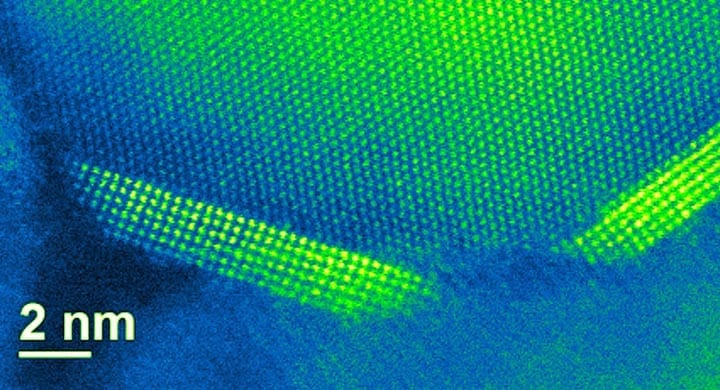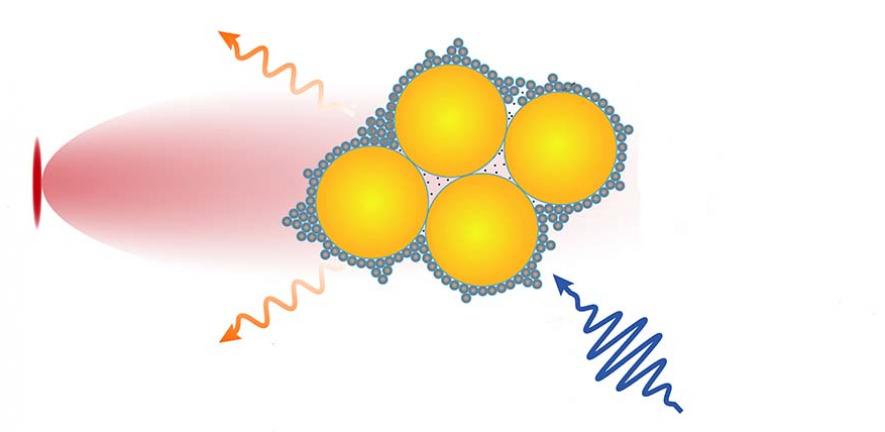
via Wikimedia
For over past couple decades, manipulating materials at the nanoscale to develop efficient catalysts for various applications, including water treatment, has been the gold standard in the field. But a new study goes even smaller – down to a single atom, the theoretical limit in material downsizing. And results show a big improvement in efficiency, with surprising new properties that cannot be achieved by nanomaterials.
The study, led by the lab of Jaehong Kim, the Henry P. Becton Sr. Professor and Chair of Chemical & Environmental Engineering, was a collaboration between Yale, Arizona State University, and the Brookhaven National Laboratory. It was published this week in Nature Communications.
When it comes to water treatment catalysts, which are used to break down pollutants, smaller is better. That’s because it increases the surface area, which increases its kinetics. But nanomaterials, as small as they are, still have clusters of atoms buried beneath the surface that go unused.
For the study, the researchers synthesized a single atom of palladium on a silicon-carbide substrate. This new catalytic system significantly improved the kinetics of destroying harmful chlorinated pollutants in water. The system’s low cost is also critical to its success. The expense of palladium and other materials with valuable catalyst properties has been prohibitive in developing cost-effective water treatment systems.
“If you break expensive palladium catalyst down to a single-atom limit, all of sudden, it becomes so cheap that it opens up new opportunities, especially for applications such as cost-sensitive water treatment,” Kim said.
One particularly valuable property of the palladium atom is how selective it is when breaking down substances. That’s crucial because if a catalyst that breaks down more than it needs to – that is, non-toxic substances – it will be wasting energy. But palladium at the single-atom level selectively breaks down carbon-halogen bonds with nearly 100% selectivity, while leaving the rest of the molecule intact. Such a high selectivity is not possible with palladium nanoparticles, which are the current industry standard.
With all of these advantages over the standard nanomaterial catalyst, Kim said the study marks a “pretty important advance in the water treatment field.”
“This not only increases the kinetics and drastically reduces the cost, it means we can do selective pollutant destruction for water treatment for the first time,” Kim said.
To build on their breakthrough, the researchers are working on integrating the material into a hydrogenation reactor and electrochemical cell to make a modular water treatment system that targets various pollutants, with a particular focus on anthropogenic halogenated, toxic organics, including PFAS chemicals.
Original Article: A Breakthrough in Catalysts: Smaller than Nanoscale
More from: Yale School of Engineering & Applied Science | Arizona State University | Brookhaven National Laboratory
The Latest Updates from Bing News & Google News
Go deeper with Bing News on:
Single atom catalysts
- Cheap Catalyst Made Out of Sugar Has the Power To Destroy CO2on May 8, 2024 at 1:46 pm
New catalyst may provide a potential solution for utilizing captured carbon. A new catalyst made from an inexpensive, abundant metal and common table sugar has the power to destroy carbon dioxide (CO2 ...
- Health Catalyston May 6, 2024 at 10:51 am
When Health Catalyst begins working with a hospital system, it makes a sweet offer: Move your engineers over to the Utah-based software firm, and they’ll keep your data running and analyzable it ...
- Scientists developed a sheet of gold that’s just one atom thickon May 1, 2024 at 10:00 am
Ultrathin goldene sheets could reduce the amount of gold needed for electronics and certain chemical reactions.
- Exploring the potential of single-atom catalystson April 22, 2024 at 12:46 pm
More information: Ziyi Chen et al, Structural Analysis of Single-Atom Catalysts by X-ray Absorption Spectroscopy, Accounts of Chemical Research (2024). DOI: 10.1021/acs.accounts.3c00693 Provided ...
- Preparation of single-atom catalysts for highly sensitive gas detectingon April 21, 2024 at 5:00 pm
Zhang's team from Harbin Institute of Technology comprehensively introduced the utilization of single atom catalysts within the field of gas sensing, proposing a new strategy to enhance the ...
Go deeper with Google Headlines on:
Single atom catalysts
[google_news title=”” keyword=”single atom catalysts” num_posts=”5″ blurb_length=”0″ show_thumb=”left”]
Go deeper with Bing News on:
Modular water treatment
- Dirty water, inconsistent billing plague neighborhood near Salinaon May 8, 2024 at 6:30 am
Misty Livingston-Holmes has lived most of her life in her subdivision northwest of Salina. She loved growing up there, and after leaving home for a few years, she moved back to take care of her ...
- Too much water, and not enough: Brazil's flooded south struggles to access basic goodson May 7, 2024 at 5:46 pm
Five of the Porto Alegre's six water treatment facilities aren’t working, and Porto Alegre Mayor Sebastião Melo on Monday decreed that water be used exclusively for “essential consumption.” “We are ...
- Half of Gaza water sites damaged or destroyed, BBC satellite data revealson May 7, 2024 at 5:00 pm
The lightweight mobile page you have visited has been built using Google ... “Ad Choices / Do not sell my info” in the footer at any time. Hundreds of Gaza's water and sanitation facilities have been ...
- Here’s how coastal Alabama water utilities are testing for PFAS, ‘forever chemicals’on May 2, 2024 at 6:40 am
After new EPA regulations last month, water utilities around the country are going to need to make changes to lower the concentration of PFAS in drinking water. Here's how utilities in coastal Alabama ...
- PFAS Regulation: The Time to Act Is Nowon May 1, 2024 at 9:07 am
Without question, compliance with the final rule is a costly proposition; it’s also potentially, a lengthy one. Modular water treatment offers a reliable, cost-effective way to accelerate the ...
Go deeper with Google Headlines on:
Modular water treatment
[google_news title=”” keyword=”modular water treatment” num_posts=”5″ blurb_length=”0″ show_thumb=”left”]










